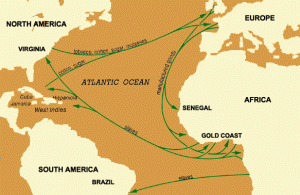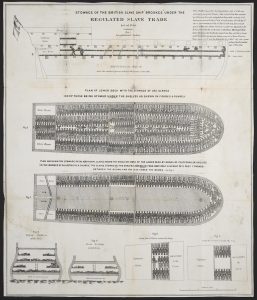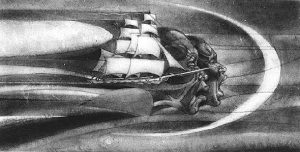
The Middle Passage refers to the trade routes taken by European and American merchant ships during the seventeenth to nineteenth centuries where millions of Africans were kidnapped and exchanged for trade goods. Millions of men, women, and children were taken from their homes, mostly in West Africa, and loaded into slave ships like cargo and treated as such. When Europeans left their ports for Africa, their ships were full of guns, ammunition, cloth, tools, and other manufactured goods to trade with African kings and those in power. When arriving in Africa, they were greeted by kings, warlords, and private kidnappers with scores of captured slaves. Records, though minimal, suggest that mortality rates were considerably higher during the capturing and transporting of Africans to the slave ships as opposed to the 15 percent of Africans who died while being shipped to the New World.
 Several hundreds of slaves were stacked below the deck of the ship, commonly separated by men and women and children. Men were normally chained together and stacked next to and on top of each other to save space, and women and children were sometimes given a little more room so they could move slightly. Air holes were made in the floor of the deck to “provide breathing air” to those captured, but were sealed when the weather was rough.
Several hundreds of slaves were stacked below the deck of the ship, commonly separated by men and women and children. Men were normally chained together and stacked next to and on top of each other to save space, and women and children were sometimes given a little more room so they could move slightly. Air holes were made in the floor of the deck to “provide breathing air” to those captured, but were sealed when the weather was rough.
There were two different ways to pack slaves into the cargo ships: “tight packing” and “loose packing.” Loose packing provided for fewer slaves per ship in the hopes that a greater percentage of the cargo would arrive alive. This meant a higher return rate to the captain and crew transporting and selling the slaves. Tight packing captains believed that more slaves, despite higher casualties, would yield a greater profit at the trading block because of the sheer numbers at the loading dock.
for fewer slaves per ship in the hopes that a greater percentage of the cargo would arrive alive. This meant a higher return rate to the captain and crew transporting and selling the slaves. Tight packing captains believed that more slaves, despite higher casualties, would yield a greater profit at the trading block because of the sheer numbers at the loading dock.
The journey itself lasted anywhere from one to six months, depending on weather conditions. During this time, slaves were starved and ridden with disease and illness. Because of these conditions, many died during the journey. However, the dead bodies were often timed left shackled to those around hem for hours or days after they had died. Dead bodies were thrown overboard like garbage.
Slaves were treated as cargo and goods, as opposed to the human beings that they were, because of the color of their skin. They were taken as currency to be traded for tobacco, cotton, and sugar. Those who survived the journey across the Atlantic to the West Indies were unloaded and presented to bidders to be sold for the highest price. Following their sale, the slaves were then reloaded and shipped to their final destination. Those that were too sick or not sold at auction were left for dead, without their family or culture.
 Because of the morbidity of the subject, children’s literature authors and illustrators sometimes struggle to depict an honest history of the slave trade while preserving a child’s innocence. Within the exhibitions, illustrators Tom Feelings, Floyd Cooper, and E.B. Lewis create incredibly vivid works depicting the Middle Passage in a powerful way, digestible for both children and their parents.
Because of the morbidity of the subject, children’s literature authors and illustrators sometimes struggle to depict an honest history of the slave trade while preserving a child’s innocence. Within the exhibitions, illustrators Tom Feelings, Floyd Cooper, and E.B. Lewis create incredibly vivid works depicting the Middle Passage in a powerful way, digestible for both children and their parents.
The books displayed in the exhibition include:
Bound for America. The Forced Migration of Africans to the New World. Written by James Haskins & Kathleen Benson. Illustrated by Floyd Cooper. Lothrop, Lee & Shepard, 1999.
Circle Unbroken. The Story of a Basket and Its People. Written by Margot Theis Raven. Illustrated by E.B. Lewis. Melanie Kroupa Books/Farrar, Straus and Giroux, 2004.
The Middle Passage. White Ships/Black Cargo. Written and Illustrated by Tom Feelings. Dial, 1995.
Written by Caroline Bastian
